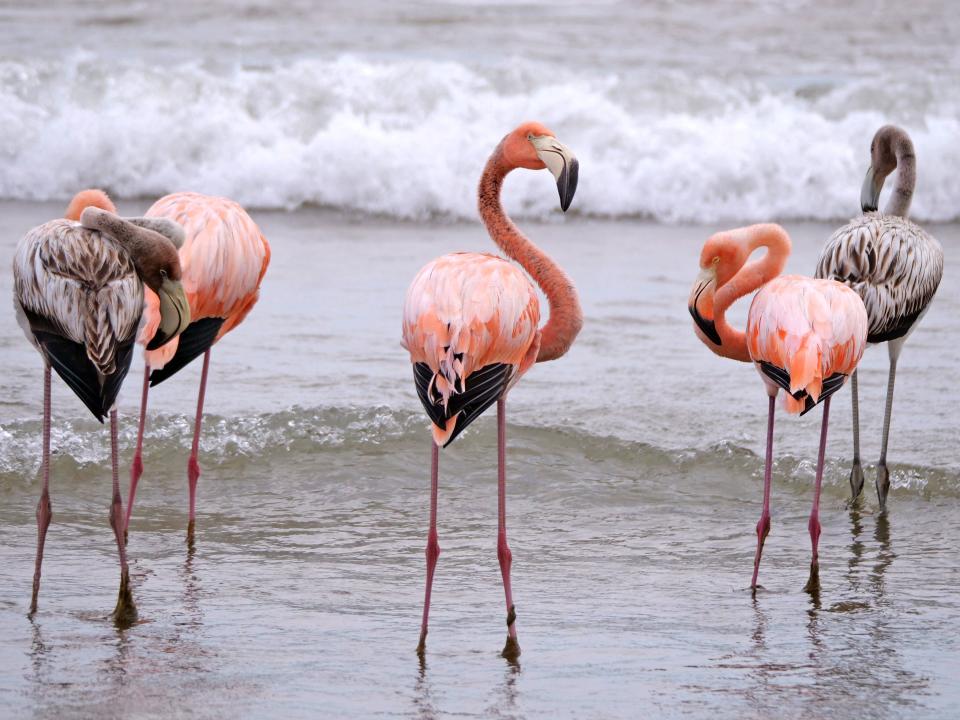A 'pink wave' of flamingos has spread to Wisconsin, Missouri and Kansas. What's going on?
Hurricane Idalia’s incredible influx of flamingos expanded deeper into the country over the past 10 days with sightings of the bright pink birds in Wisconsin, Missouri and even Kansas.
Bird-watchers and others first spotted flamingos dropping out of the clouds as Idalia arrived along Florida’s west coast on Aug. 30. Over the next four weeks, at least 150 American flamingos were seen in more than four dozen locations across Florida and in at least 14 states.
Flamingos are seen from time to time in Florida and the birds – real and plastic – are synonymous with the state’s tropical vibe, so the sightings there may not be all that extraordinary. But Wisconsin? And the Ohio River?
A flamingo rocked the world of Kansas birders this week when it showed up in Chase County Lake in the Flint Hills. An unconfirmed sighting reported a flamingo in Missouri the evening before.
“It’s amazing to me that so many people all over the country got to experience this,” said Amy Davis, associate editor for North American Birds for the American Birding Association. “They’re just so beautiful and so gawky.”
At least five of the flamingos were traced back to the Yucatan Peninsula in Mexico and experts surmise they were somehow picked up in the bands of Idalia’s winds as the storm lingered over the northwestern Caribbean Sea.
Now it appears the birds may be returning southward, said Jerry Lorenz, state director of research for Audubon Florida, which dubbed the event “the pink wave.” But he and others hope some of the birds remain.

Flamingos in Wisconsin?
A flamboyance of flamingos showed up in Lake Michigan at Port Washington, Wisconsin on Sept. 22. Word of their arrival quickly spread among birders, who flocked to the lake.

When Dexter Patterson, a faculty associate at the University of Wisconsin-Madison, got the call from a friend, he thought it was a joke, in part because Madison is the site of one of the greatest plastic flamingo pranks of all time, he said.
“I was like get out of here,” said Patterson, co-founder of the BIPOC Birding Club of Wisconsin. His friend soon sent a second message confirming the birds were real.
“I was like how fast can I get in my car and get to Port Washington,” he told USA TODAY. “It was a Friday and I have no classes on Friday.” The trip took about 90 minutes, he said, but it was “worth it.”

It was the state’s first documented wild flamingo sighting and the only day sightings were reported in Port Washington.
The next day, a group on a boat reported seeing five flamingos on the Wisconsin River, roughly 100 miles to the west. Because it was the same combination of three pink adults and two grey juveniles, birders think it might have been the same flock, since the birds weren’t seen again in Lake Michigan.
What was the flamingo prank in Madison?
On Sept. 7, 1979, two leaders of a student government association placed 1,008 pink plastic flamingo lawn ornaments on the school’s Bascom Hill, according to the alumni association. The prank became an annual tradition and fundraiser. Then in 2009, the pink plastic birds were named the official bird for the city of Madison.
Where did these flamingos come from?
Flamingos from breeding populations in the Caribbean have been blown into the U.S. with hurricanes before, said Jennifer McKay, a wildlife biologist in the Bird Banding Lab at the U.S. Geological Survey's Eastern Ecological Science Center.
This time there are more birds in more locations, experts told USA TODAY.
Through correspondence with the Pedro and Elena Hernández Foundation, Lorenz and others learned that most, if not all, of the flamingos likely came from the Ría Lagartos Biosphere Reserve on the Yucatan Peninsula in Mexico. The Foundation is one of two environmental nonprofits placing identification bands on birds in the reserve, where many migratory flamingos gather for the summer breeding season.
The reserve is less than 500 miles from South Florida, said McKay, the lab's liaison with bird banding partners around the world. "If they got a lot of oomph from a tailwind, it's an easy hop, skip and a jump."
Three birds banded in the reserve have been reported in the U.S. over the past decade, McKay said. Since Idalia, six birds banded there have been reported, she said, five in Florida and one in North Carolina.
One of the flamingos seen in the Florida Keys, was banded as a chick in 2000, making it 23 years old, said Maria Hryniewich, a South Florida birder who talked with the bird banders in the Yucatan. The 23 years makes the flamingo the second-most long-lived wild American flamingo in the geological survey's database. The bird was seen in Florida at least seven times between Sept. 1-23.
What’s happening to the flamingos?
At least five flamingos have died, Lorenz said. Of three that were taken to rehabilitation centers – including a flamingo attacked by a snapping turtle in Pennsylvania – only one survived. That bird, rescued off St. Petersburg Beach, recovered and was released after being fitted with a satellite transmitter under a research permit from the geological survey. Scientists say the bird may provide valuable information about the eventual destination of the Idalia flamingos.
Based on recent sightings, Lorenz said it appears the flamingos may be moving southward and beginning to form larger groups. A group was seen in Charlotte Harbor, on Florida's southwest coast, he said. A group of five in Mosquito Lagoon on Florida's east coast has become a group of a dozen. And a growing flock in Everglades National Park has reached 75 birds, according to a Sept. 23 report on eBird, a voluntary bird reporting website.
Once it starts getting a little chilly, Lorenz believes the birds will all head south. "Whether they’ll stay here or not is the question," he said. "Hopefully, they’ll stay in Florida, but I suspect they'll end up going even further south."

Are flamingos endangered?
None of the world's six species of flamingos are classified as endangered, but four are considered near threatened or vulnerable by the International Union for Conservation of Nature’s “red list.”
The flamingos being seen in the U.S. are American flamingos, also known as Caribbean flamingos, and the conservation union considers them a species of "least concern." Their home range includes the Caribbean, parts of the southern Gulf and Southeast coasts of the United States and the northern coast of South America.
Though their numbers were reduced by as much as 80% by feather hunters between 1880 and 1905, the species rebounded, according to a study Lorenz co-authored. A 2020 conservation union assessment estimated the population at 150,000-200,000.
They are protected in the U.S. by the Migratory Bird Treaty Act.
Are flamingos native to Florida?
Yes. Thousands of the birds were reported in South Florida in the late 1800s, but they were believed to be eliminated by feather hunters by the early 1900s.
Sightings and the numbers of birds seen in those flocks have increased in recent years, Lorenz said. For example, a flock of more than 140 birds was seen in South Florida in 2011.
Although no nesting has been documented, there could be birds nesting in the Everglades already, Lorenz said. “We just don’t know where to look."
At least 3,476 square miles of protected public land is found in Everglades National Park and Big Cypress National Preserve at the tip of South Florida.
Several scientists point out that the locations where many of the birds have been seen, including several national wildlife refuges, are a testament to land conservation and restoration programs in the U.S.
By efforts to fix the Everglades and restore the water quality in South Florida, "we may have repaired Florida Bay to the point where it can sustain flamingos again," Lorenz said. "We're hoping this pink wave will be the re-establishment of that population."
This article originally appeared on USA TODAY: Hurricane Idalia flung flamingos across US: What states are they in?
Solve the daily Crossword

